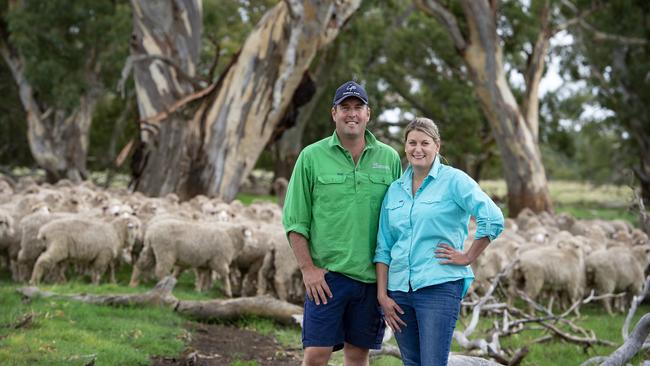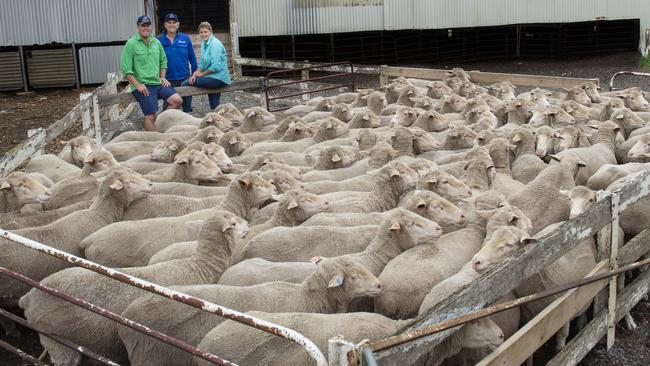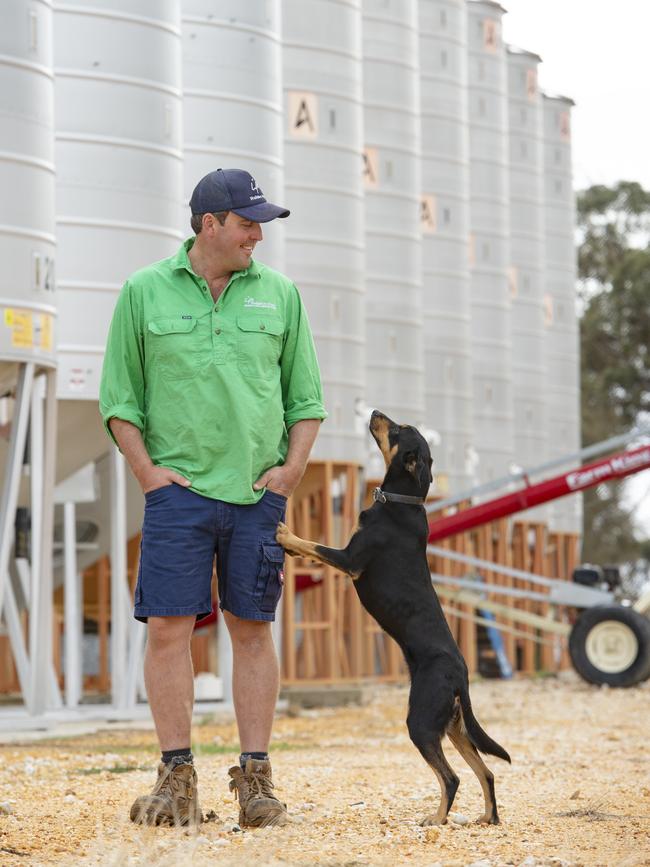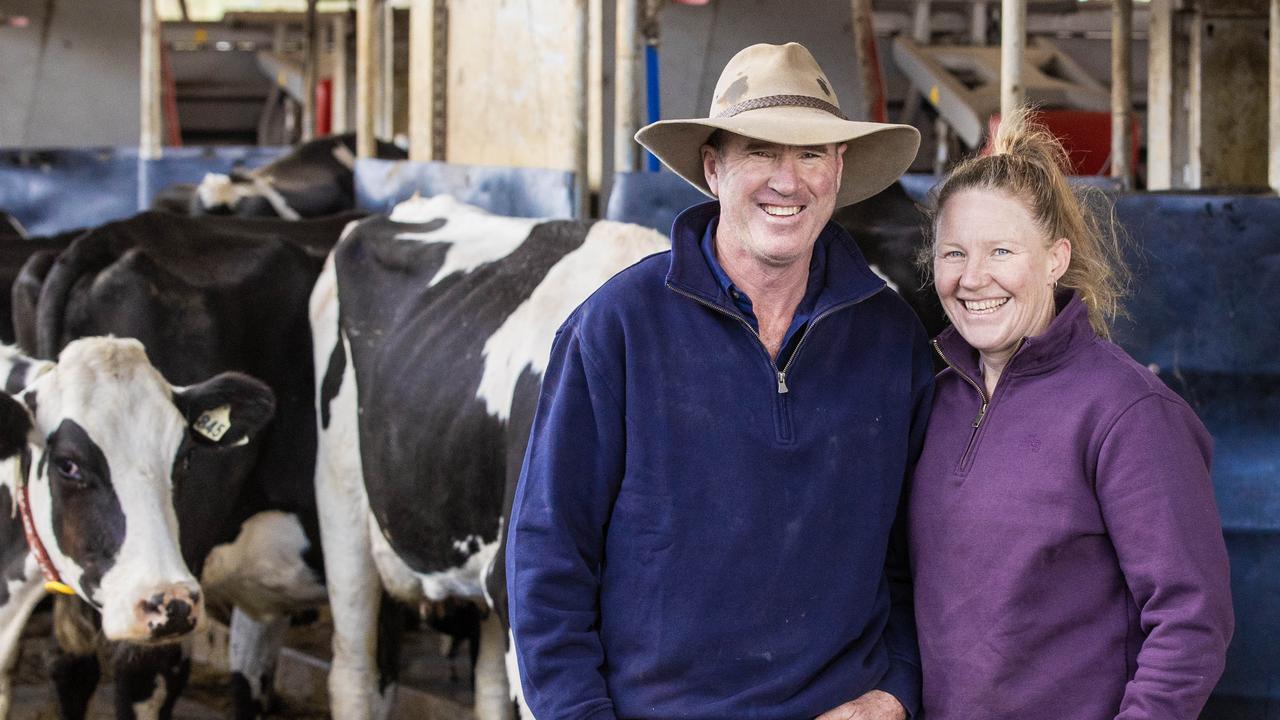Victoria’s biggest Merino stud brings data know-how learnt in cropping to grow business
Marnoo’s Carter family has honed their mixed-farm gross margins to enable a six-fold growth in land size beyond their traditional Merino-stud holding. Here’s how.
One of Australia’s best known Merino studs – Wallaloo Park – has melded the tradition and value of their quality-wool producing Merinos with a growth mindset, seeing the family business become a major mixed-farming enterprise in the Marnoo district.
The Carter family’s broadacre and stud Merino sheep business is now 4000ha, thanks to steady acquisition of land over the past 30 years.
With property prices skyrocketing in many regions, in what now looks like an inspired move, the family bought small parcels of land every year or two since the 1990s.
John and Jenny Carter, their son, Trent, and his wife, Kate, run this growing family business and while best-known for their Wallaloo Park stud Merinos – medium-wool sheep, well-balanced and increasingly meeting dual-purpose goals of their clients – there is much more to their story.

The Carters have moved towards proven sheep breeding values, but, as Trent is keen to emphasis, in a considered way.
“We’ve always been known for our wool quality – using data collection over the past 10 years has set us up for breeding an early maturing, dual-purpose animal that will fit into all environments,” he said.
On the cropping side the “airseeder goes over 3000ha annually; 2000ha of cash crops and 1000ha of green manure vetch, annual grass and hay production”, he said.
“We try to maximise every bit of rainfall.”
STRONG TIES
TRENT said the Carters first settled at Brim Springs in the Wimmera two years after surveyor and explorer Major Thomas Mitchell first visited the region. They have been at Marnoo for more than 100 years.
John came home in 1972 when the holding was 600ha with the same amount leased. When Trent returned home in 2005 the farm was 1600ha, running 2000 ewes and cropping 600ha.
The operation is now spread over 4000ha – 15 per cent of which is leased.
John and Jenny started the stud in 1979 after winning Elders flock of the year with a 21-micron flock cutting 8.6kg of wool.
It was initially based on the South Australian Merino Collinsville and Banavie bloodlines. Collinsville ended up using a Wallaloo ram in later years that John said started “one of Collinsville’s famous wool families”.
When they started out the couple bought a ram for $10,000, then one for $15,000.
“That was a lot of money at the time but we thought if we’re going to do it we’ll do it properly,” he said.
This steadfast approach has, at times, gone against advice. John recalls meeting a well-known consultant in Melbourne, who recommended giving the stud away.
“We never went back to him,” John said.
Wallaloo Park has since held the Australian on-property sale records numerous times during the past 30 years.

Wallaloo Park has since held the Australian on-property sale records numerous times during the past 30 years.
Dr Jim Watts also did a lot of work with the stud helping refine the skins and wool quality, along with Jenny’s skills in wool evaluation.
“(Jim) changed the face of the whole Merino industry, he was responsible for dropping the national clip by two microns,” John said.
The stud is coming into its 30th on-property sale and features 200 rams, with the flock now 19 micron. Last year it topped at $16,000, and a Carter ram sold for $76,000 at the Adelaide sale. Wallaloo Park is also the biggest Merino semen seller in Victoria and the second biggest ram seller.
DUAL PURPOSE
IN the early 2000s John and Jenny recognised growing demand for better sheep constitution and reproductive ability and the stud started moving towards a dual-purpose goal.
“We’ve always been conscious wool was our trademark, but as meat prices have gone up, we are now trying to breed a dual-purpose animal,” John said.
“It is no good having a fantastic fleece on an animal that can’t reproduce or survive.”
Despite all the earlier success John said now was the most exciting period to be involved with sheep breeding and with both generations “on the same page”.
Trent said the stud and flock ewes now cut 8.5kg wool cut and weaned 130 per cent lambs.
“The strength behind it now is everything is measured and there is data behind everything we’re doing,” he said.
After working at Geelong Grammar’s Timbertop’s campus Trent worked on farms interstate and abroad then studied at Marcus Oldham before returning to Marnoo in 2005.
“In the late 2000s we bought a lot of land from neighbours; the stud was well established and we grew the cropping side of it, it was the easier way to grow,” he said.
The farm had been the first in the region to adopt minimum till in the 1980s on their red and clay loams, with a rainfall of around 400mm winter-dominate annual rainfall.
“When I first came home we went hard with land purchases,” he said.
“Equity was right down and things had to be pushed with business structure and gross margins per hectare had to be constantly tweaked. The business and stud have both never sat idle, we are constantly pushing things to make it more sustainable and viable.
STAYING AHEAD
TRENT said the business was “still in a growing phase so we don’t even look at equity, it is all about gross margin per hectare”.
For broadacre land, Trent said he expected a gross margin return of $1000/ha. For livestock returns of $560/mature ewe per year in the stud and commercial enterprise over the past two years.
Maximising the return on every drop of rain that fell was the aim, with copping systems using practices such as stubble retention and extensive summer weed spraying all geared towards retaining moisture to produce grain.
“We’re farmers of moisture, whether it goes into grass, wool or grain,” he said.
“The last two years we have had $1400GM/ha but we’ve had exceptional years and prices whereas in drought years it has been more like $800/ha.”
He said rolling averages of returns on investment and other measures could vary year-to-year depending on investment purchases, so it was more important to look at GM/ha.
“We have a pretty robust business now with an even mix of machinery, different land uses – integrating livestock and cropping that helps drought proof the business.”
While John said a solid education was invaluable for a farm manager to understand the business and its finances, Trent added that once a business got to scale, finetuning made “a huge difference to the bottom line”.
GOOD NETWORK
AS WELL as the four family members the Carters have two full time employees and use specialistic contractors.
While income is evenly split between sheep and cropping, labour, mostly due to the stud’s data collation requirements, carried 75 per cent of the labour costs.
Marcus Oldham connections continue to help the business, with the Carters regularly hosting graduates for their mid-year.
Kate said that network had been a great resource for information and innovation.
Kate is a nurse by profession, but sheep are in her blood as she grew up on the Banyenong West Poll Dorset stud and now works in the Wallaloo business.
The farm’s main crops in the 2000ha of cash crops – wheat, barley, canola, oats, beans, lentils – as well as 1000ha dedicated to fodder crops, annual grasses and some perennial grasses, although their longevity was challenged as plant breeding programs focused on 600mm-plus rainfall regions.
The cropping system uses the latest practices, such as full precisions agriculture with all variable rate input applications on a no till system, inter-row cropped on 300mm spacings and measuring and mapping all PH and sub soil parameters in soils.
Some of these practices were being implemented on the grazing country as well.
EFFICIENCY GAINS
LEARNING from the experience of the cropping industry, where technological advances had made growing crops more efficient and inputs better-matched to paddock or plant needs, Trent said there were huge efficiency gains to be made in the stud sheep industry using data. For Wallaloo Park, a significant move from a more traditional approach to stud breeding and a greater emphasis on wool quality and cut came when data collection started in earnest in 2012.
“We were gathering as much data with the rams as we could, and in the past four years we concentrated on the dam side,” he said. And much progress has been made, with the Wallaloo ewes now weaning an average of 130 per cent lambs.
“We collected as much data as we could until 2017, and got breeding values to see where we sat in the industry; we introduced some trait leaders within ASBVs to fast-track where we were with proven performers,” Trent said.

“In this whole period we have not lost sight of our wool quality, and we’re not chasing rainbows in regards to data, we still want an animal that stands correctly and has all the correct physical attributes and maintain our wool quality.
“It’s a slow process, you can throw the whole tool kit at it, but you will drag in undesirable traits, which we don’t want to do.
“We’ve been patient and wanted to get a total understanding of the breeding values.
“We’ve got a very good level on where we sit in the industry and where we need to go.”
Triggervale and Moojepin genetics have been some of the proven outcrosses used, as well as Wallaloo Park rams, lifting carcass and fertility traits.
Technology like Smart Shepherd lamb and ewe bluetooth collars also helped with pedigree data. “We’re also going to look to DNA test our joined ewe lambs this year, which scanned at 77 per cent conception at eight months with 48 per cent carrying multiples” Trent said. Ewes aren’t culled on age but on performance, with some 10 years old.
FAST PACE
IN TOTAL Wallaloo Park runs 2500 ewes, studs and commercial, but all are individually pedigreed.
And the weaning percentage is now 130 per cent – a boost up from 100 per cent 10 years ago.
At Marnoo, the production program is hectic with the long-stapled sheep producing fleeces that require shearing every eight months February, June and October, to deal with 80mm staples.
Trent said frequent shearing had animal welfare benefits – the stud is non-mulesed – and it also helped maintain tensile strength.
“At the moment the push in the industry is on fat and muscle – there are virtues in it and we’re part of the way there, but our biggest focus is on post weaning weight, number of lambs weaned and staple length,” he said.
“We’ve always had early maturing sheep but the focus on carcass traits have really helped us better balance the animal with better muscle and fat, and rear better lambs as well.”
Looking forward, Trent said given the recent growth in land prices, expansion was “probably a bit hard now, so the future is really homing in on our hectares and livestock inputs and management”.
“You are really only as good as your bottom 10 per cent so its all about finetuning, such as PA in the broadacre, which will flow back into the livestock business.
“We will also focus more on data in the livestock side of things.
“Electronic identification is an absolute game changer, and the data collection it enables.”
The impact of the data collection and use was starting to become apparent in the ram sale results, with rams featuring improved ASBVs averaging around $1000 more.
Trent said agriculture was now an exciting place to be.
“Having a dual enterprise here with livestock and cropping, the integration works really well in this environment, the technology in the cropping and in the past 10 years also in the livestock industry is fascinating, and for the production and financial gains across our business has been exciting and is what drives us and will keep us going into the future.”
MORE
HAMILTON WOOL GROWER SETS GOLD STANDARD
AWI: WOOL-GROWER BODY’S RULES QUERIED IN SENATE ESTIMATES
DEBATE OVER FAT AND MUSCLE TO BE SETTLED IN SHEEP STUDY, INDEX REVIEW


